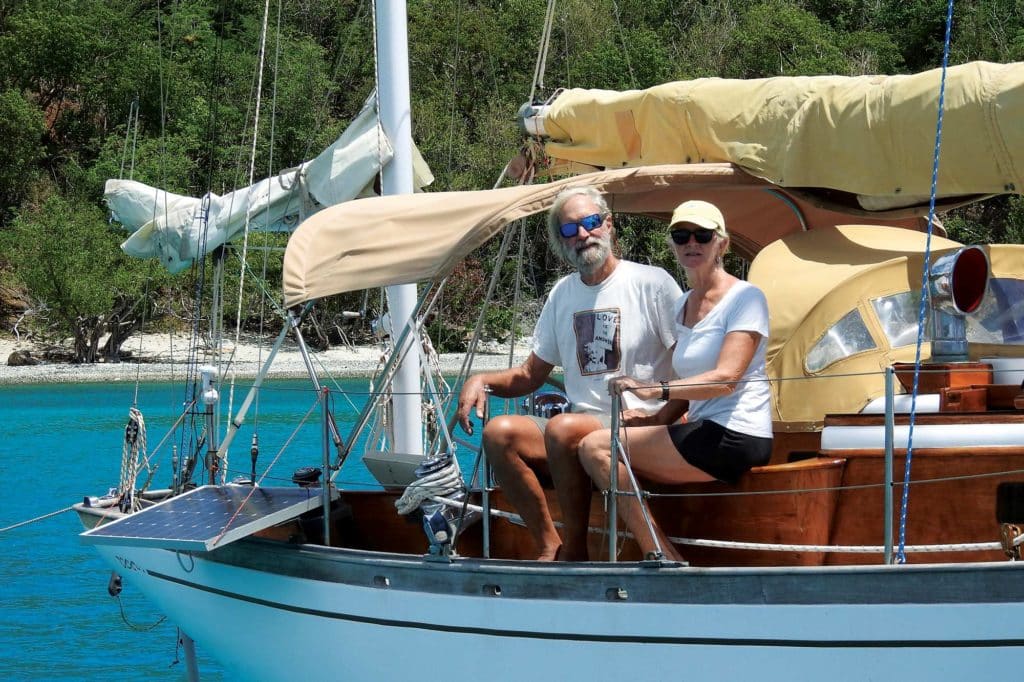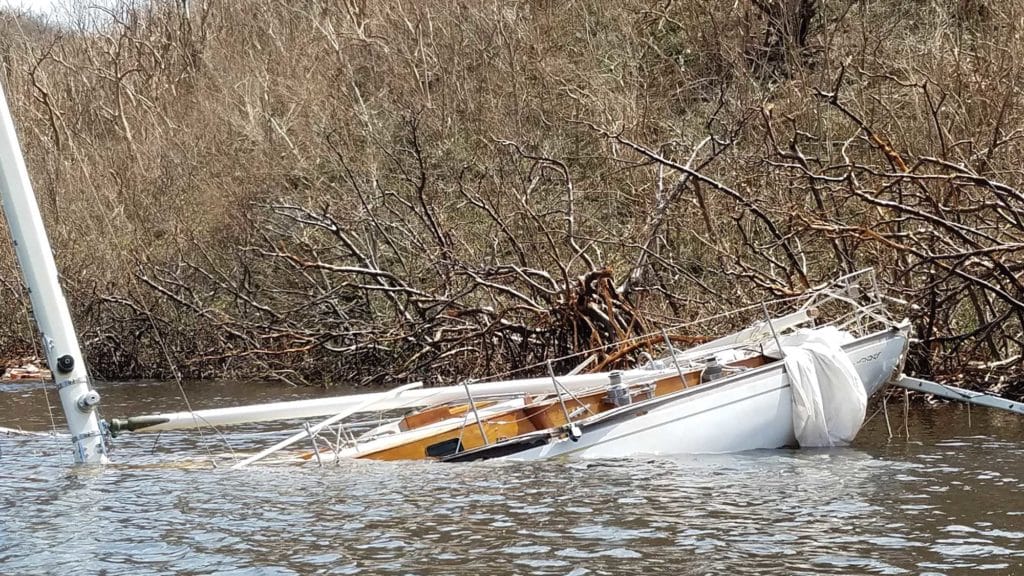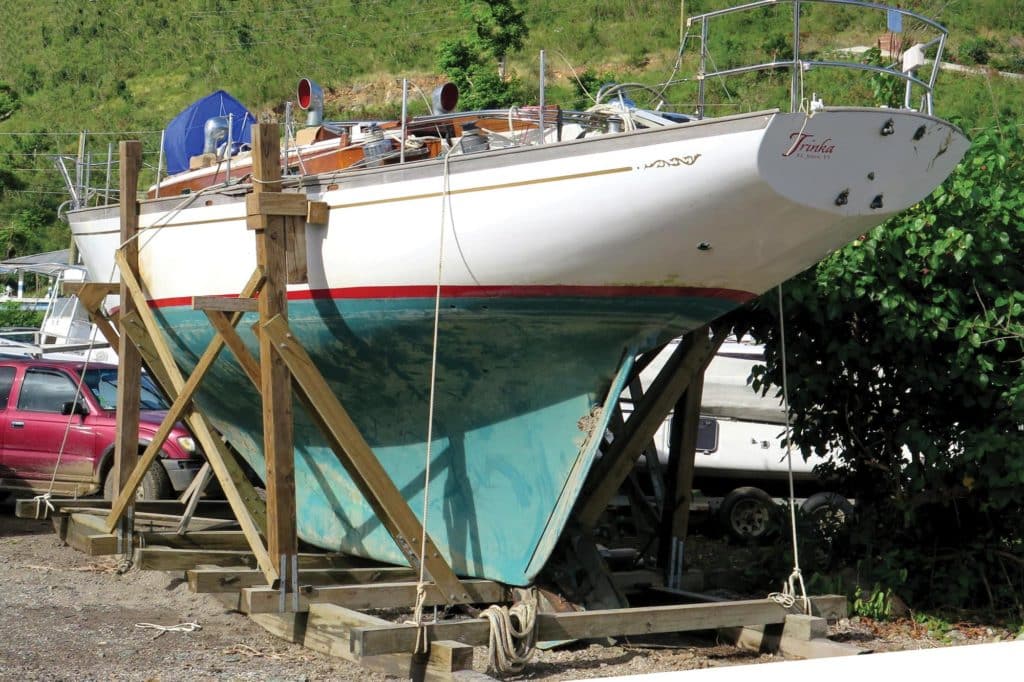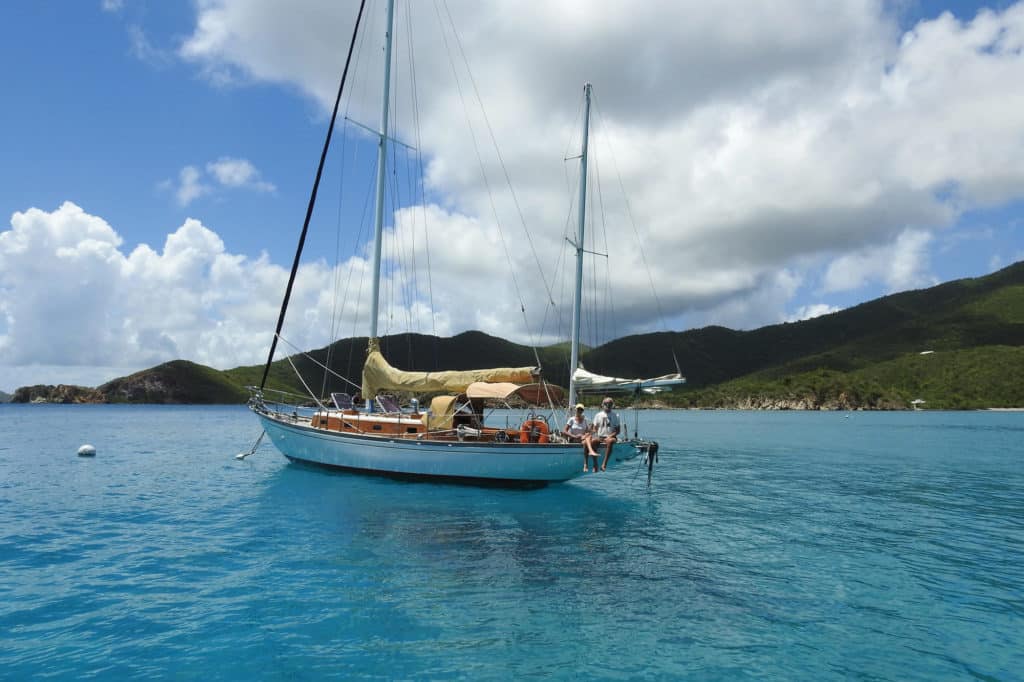
It is difficult to describe the utter devastation of a Category 5 storm such as Hurricane Irma because any accurate attempt seems like wild exaggeration. An 80-foot twin-engine catamaran with a generator and full fuel tanks blowing through the air like a 40-foot-wide tumbleweed? A 50-foot monohull whose barometer momentarily functioned as an altimeter before the boat landed on the roof of a government building? Entire harbors a sea of blue from the antifouling of the capsized rental catamarans?
Crazy, right?
Thatcher Lord and his wife, Vicki, couldn’t believe their eyes on September 6, 2017, as they forced open the door of their battered home enough to escape. The hillside on St. John, in the US Virgin Islands, appeared to have burned, as if magically incinerated during the torrential rains. There wasn’t a speck of greenery. Mighty trees were gone. Ditto the stone walls of sugar plantations that had stood for centuries. Thousands of houses were now mere smears in the dirt. Giant trucks had been swept into the sea. There were businesses so flattened that you couldn’t tell where they’d once been. Whole roads had slid into the valleys below.
“We’ll never make it, Thatch,” Vicki recalls telling her husband. “Bjork Creek is too far. Besides, sections of the road are missing and the rest of Centerline is so cluttered with debris that transiting it is more a climb than a hike.”
“I just want a look,” she remembers Thatcher telling her doggedly, as he climbed over the trunk of a tree in the middle of the asphalt in front of their house. “I know there’ll be damage. That’s a given. All I want is to make sure she’s floating. That’s all.”
Thatcher is a soft-spoken man, though the softness of his words somehow communicates strength. He wouldn’t be able to sleep until he knew his beloved Rhodes Reliant 41-foot fiberglass yawl, Trinka, was OK. They’d owned her for nearly three decades. All their spare time had been lavished on her; all their pennies too.
About two hours into the eastward hike down Centerline Road, Thatcher crested a pile of debris that had once been someone’s house and came face to face with Bad Nate. St. John is a small island with only a few thousand residents. Bad Nate’s eyes were dilated, and his teeth chattered as if he’d been staring into hell’s fires.
“She’s gone,” he croaked to Thatcher.
“What do you mean, gone?” Thatcher asked.
“Gone as in not there,” Bad Nate said. “Only one boat survived in Bjork Creek, the red-hulled Shibumi.”

Shibumi was owned by Dick Burks and Mary Tyler, two of Thatcher and Vicki’s best friends. Thatcher was happy to hear their boat had survived, even if the news came in such a backhanded, gut-wrenching manner.
Vicki was a few strides behind, but she’d heard as well. Worse, she’d seen Thatcher flinch as if he’d been whipped. Vicki wondered if her husband could handle all the drama, all the stress. He’d spent a decade wrestling with cancer, which he may have licked. But the long hospital stays and the bone-marrow transplant had drained them emotionally, physically and financially. Thatcher was a shadow of his former strapping self.
Two hours later, they rounded the point by Estate Zootenvaal and peered into Bjork Creek. Bad Nate had been right but also wrong. Trinka had been lost, but Thatcher knew exactly where she was: directly under those masts standing above the water that he’d once taken apart and reglued himself.
Thatcher waded into the now-still creek and swam out to his boat. Trinka was hard to look at. There was something obscene about her this way. It was too intimate, as if he should, as a gentleman sailor, glance away. He dived down and felt her wounds. She was holed and cracked and crushed. Sections of her transom had been eaten. Huge chunks of her rails had been pounded off. Only a tiny bit of her transom protruded forlornly above the water.
It wasn’t a judgment call. If she’d been insured, she’d be a total write-off, but of course, she wasn’t. It made no sense to attempt to fix her; the cost in both money and time would be astronomical.
“What do you think?” Vicki recalls asking from the shore.
“What do I think?” Thatcher snapped. “I think I want to cry.”
Over the course of the next month, Vicki researched their situation. While the Federal Emergency Management Agency and the Army Corps of Engineers quickly started removing all the sunken vessels in nearby Coral Bay without charge, Bjork Creek was in National Park Service waters. Almost a year would go by before the NPS would bring in a crane. So, in a sense, the Lords could do nothing but walk away.
But somehow walking away to callously leave Trinka’s corpse on display for a year didn’t seem right.
Thatcher bristled at the idea. He couldn’t decide whether to do the logical, sensible thing or the silly thing, so he asked a few of his knowledgeable friends for their opinion. I was one. I dinghied out to Bjork Creek and looked at the remains of the now brown-and-green Trinka. Then I gave him advice: “Forget it, Thatch,” I said. “It would take years and every penny you have, maybe every penny you will ever have.”
It was unanimous. Everyone agreed. Walk away, Thatcher, walk away!
And Thatcher agreed. But then, one afternoon, he and Vicky were driving past the Coral Bay Lumber yard, and, on a lark, Thatcher pulled in. A West Indian friend named Rupert greeted them with a wide smile. Thatcher asked if they had fir 6-by-6-inch lumber, 20 feet long. Rupert said they did.
Vicki was shocked to see Thatcher’s credit card flash in his hand. And so, the project began.

Plugging the major hole underwater with a sheet of plywood and Vicki’s yoga mat wasn’t easy. Thatcher found he could hold his breath long enough, but it was difficult to stay in place with the awkward materials. His friend Dick Burks dived into Bjork Creek to assist and held onto the side of the slimy cap rail of the sunken boat. Thatcher then dived underwater and sort of allowed Dick to stand on his shoulders to keep Thatcher in place with some stability. It was tough work. It took many hours. They managed.
Then came raising the sunken boat with float bags, bringing her to surface, and pumping her out.
A month underwater hadn’t been kind to Trinka. She looked like a slimy prop in a horror movie. And she apparently seemed angry at having been disturbed. The next day when they returned to the creek, she was on the bottom again. And a few days later, again she sank! But Thatcher was totally committed to the rebuild. He’d stay the course—even if it killed him.
“Once I purchased the big timbers for the cradle,” Thatcher said later, “that was it. I knew that if I started, I’d have to complete the project. Once I began, failing wouldn’t be an option.”
As mentioned, Dick and Mary of Shibumi were friends with the Lords, but that is an understatement. Dick and Mary were delighted to still have their home afloat, and translated that joy into hard, sustained work assisting in Trinka’s reincarnation. They didn’t just “kinda” help salvage the graceful yawl; they and a dozen other St. Johnians pitched in for days, weeks, months—and a few for years—of regular labor.
Once Trinka was moved from Bjork to nearby Coral Bay, work began in earnest. It was December, and Thatcher, a wood butcher and furniture-maker by trade, sliced and diced up the 6-by-6s to fashion a cradle that wasn’t merely strong enough to support the heavy-displacement Trinka, but it was also rugged enough to be dragged ashore with her in it.
Read More about Vicki, Thatcher and Trinka: Virgin Island Sailors Bounce Back
If building the cradle ashore weren’t difficult enough, it had to be floated out to Trinka, then weighed down and sunk so that Trinka could be loaded into it.
In mid-January, four months into the two-year project, the boat was firmly fastened in the cradle and she was skidded out of the water on plywood, using come-alongs and tractors, not to mention the help of half of the island community, both West Indian and continental.
Like the West Indians say, “Hurricanes blow all skin one color!”
While Thatcher stared at all the hull damage, Vicki and Mary went inside the dripping vessel with buckets and worked for three days. Wearing the same odoriferous clothes, they mucked the mud, oil, grease and diesel fuel out of the interior. Stinking barnacles were everywhere. Pieces of Thatcher’s six-string guitar floated in the bilge, along with a shoe and bits of the Lords’ Maine wedding pictures.
“I couldn’t think of all the projects required,” Thatcher confessed. “It was too daunting, too impossible. I just did one thing at a time. I didn’t look ahead; I just looked down, and put one foot in front of the other.

The big hole in the hull was gaping, and had lots of compound curves, so he made a mold and fiberglassed over it. Then he removed the mold and glassed the other side. Then, and only then, did he think about the cracks, another hole and the pulverized area by the rail.
Most of the bulkheads were salvageable, but much of the interior plywood was delaminated. The settee, galley and all the cabinetry had rippled from the immersion. Thatcher laboriously cut it way with a chisel until he found good wood.
He had some bits of luck. He stumbled into a pile of air-dried Burmese teak. The owner of a destroyed CSY 44 sold him its mainmast cheap. Thatched used the Sitka spruce from his box-section mainmast to repair his mizzen mast. And a sad sailor on St. Thomas had a brand-new 30 hp Yanmar diesel still in the carton because his boat had sunk before he could install it. One man’s bad luck is another man’s good.
Thatcher had built his house primarily because he wanted a woodworking shop. It was here he band-sawed teak planks into 1/16-inch slices, attached them temporarily to other blocks of wood, and then ran them through his joiner/planer, making his own teak veneer.
He and Vicki worked side by side, day after day. When they began, she wondered if this project would, literally, kill Thatcher. But as the months wore on, she realized that her husband was no longer obsessing about his health because he had Trinka to worry about. He became stronger and more confident. He not only gained weight, he gained muscle. Within a year, Thatcher once again resembled the handsome Viking he’d once been.
He tossed in the new engine, and replaced all the wiring, plumbing and tankage. There was a new stove and LED fixtures, along with solar panels and controllers, of course. All the sailing and nav instruments were deep-sixed and replaced as finances permitted. Ditto the windlass and roller furler. While he was at it, why not replace the original chainplates? Thatcher wasn’t making Trinka as good as new—she’d be even better.
The longer the project dragged on, and the more the local landlubbers thought Thatcher and Vicki were crazy, the more local Caribbean sailors chipped in to help. It was almost as if Trinka had morphed into the local sailing community’s vessel; Vick and Thatch just happened to skipper her. And when the work was done, it seemed as though the whole island showed up for the flag-snapping launch.
Then, on Christmas Day 2019, they went sailing—Vicki, Thatcher and Trinka. Crazy, right?
The Goodlanders are staying put in Singapore these days and enjoying time with the grandkids.








